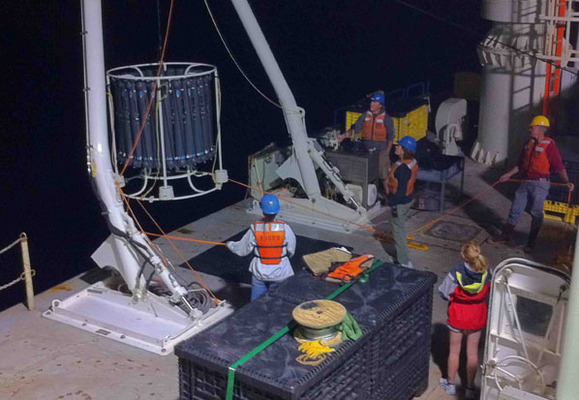
by Jeremy Jacquot Friday, January 20, 2012

The crew prepares to deploy a trace-metal clean rosette system. Jeremy Jacquot
Think of the cleanest, most meticulous person you know and multiply that attention to detail by about an order of magnitude. That’s what it takes to be considered trace-metal “clean.”
Though that probably sounds like hyperbole, it may be if anything a gross underestimate — depending on the element involved. Indeed, the concentrations of certain trace elements are so minute as to render any samples instantly prone to “contamination” from the air or any number of outside sources.
That is why researchers take extreme precautions when collecting seawater samples to measure them. The GEOTRACES scientists use what is called a trace-metal clean rosette system: a circular, powder-coated frame that typically holds anywhere from 12 to 24 large sampling bottles and is lowered over the side of the ship with a thick, Kevlar-coated line. (The Kevlar and powder coatings are intended to minimize contamination of the sampling bottles, which are themselves coated in water-repellent Teflon.)
To capture samples from throughout the water column, the system can be remotely programmed from the ship to snap the bottles shut at specific depths as the rosette ascends. This allows scientists to closely scrutinize the various chemical and biological niches that give form to the environment and thus identify particular features of interest — say, a minimum in the dissolved oxygen concentration or a maximum in chlorophyll a, a pigment used to quantify levels of primary production.
Upon the rosette’s return to the surface, the samples are immediately filtered to remove all but the tiniest microorganisms and organic matter — typically anything smaller than 0.2 or 0.4 micrometers (a millionth of a meter) in diameter — and stored in acid-washed bottles for later analysis on board or back on land. The filtering is commonly done in the ship laboratory or in so-called “clean vans,” essentially repurposed shipping containers outfitted with laminar flow hoods to keep air particles out and covered from top to bottom in copious layers of plastic sheeting to ward off most potential sources of contamination.
Unlike its better-equipped counterpart and oceanographic mainstay, the CTD (which stands for “Conductivity, Temperature and Depth”), a rosette does not possess a suite of sensors to measure the physical parameters of seawater. However, for the types of “clean” sampling that trace metal chemists engage in, it is an indispensable tool.
Without it, and without the significant advances made in clean sampling methodology in recent decades, researchers would still be incapable of accurately measuring a range of elements and isotopes.
© 2008-2021. All rights reserved. Any copying, redistribution or retransmission of any of the contents of this service without the expressed written permission of the American Geosciences Institute is expressly prohibited. Click here for all copyright requests.